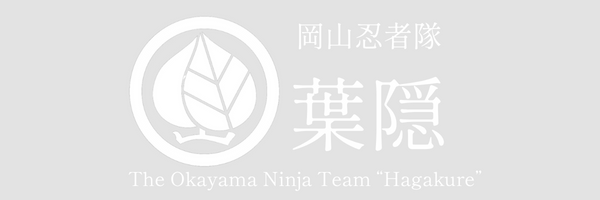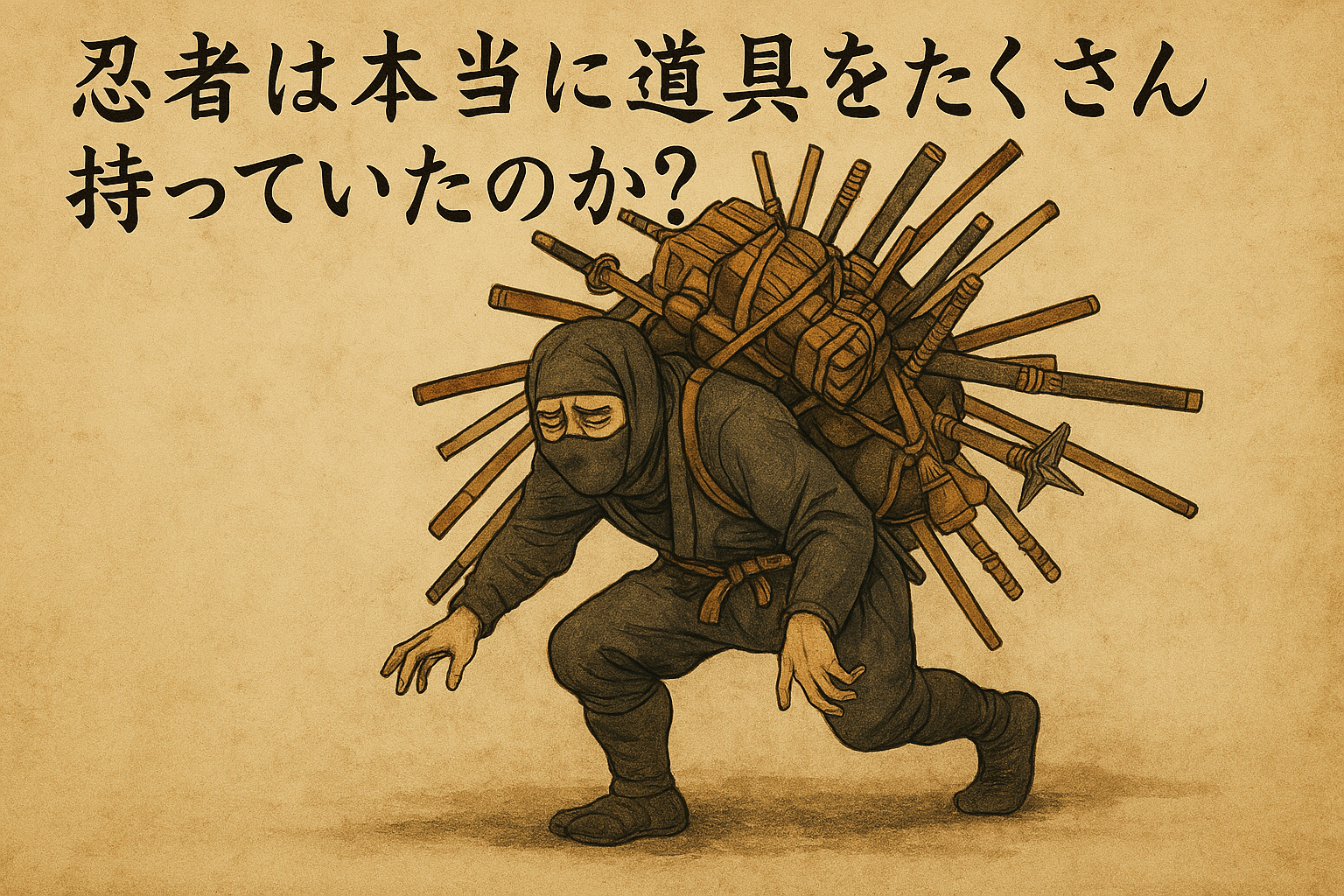忍者は本当に道具をたくさん持っていたのか? 忍具と“最小限”の知恵
忍者といえば、手裏剣、マキビシ、苦無に煙玉――さまざまな忍具を携えておる姿を想像する者も多かろう。
アニメや映画では、背中に山のような武器を背負い、手裏剣を雨のごとく投げ、爆薬を仕掛けながら華麗に跳躍……
うむ、確かに格好良い。しかし、それはあくまで「忍者フィクション」の世界の話じゃ。
実際の忍者――とくに本物の任務をこなしておった忍びの者たちは、そんなに大量の道具を持ち歩くことはせなんだ。
なぜなら――「目立つから」「重たいから」「必要ないから」じゃ。
1. 隠密行動にとって、荷物は“敵”である
まず大前提として、忍者の任務の多くは「潜入」「偵察」「密偵」「脱出」じゃ。
戦うために潜るのではない。戦わずして任務を果たすことこそ、忍びの極意。
そのためには、軽装で静かに動けることが最優先。
鉄の手裏剣を何十枚も腰に下げ、火薬や煙玉を袋に詰め込み、武器を背負っていたらどうなるか?
音は鳴る、身は重くなる、走れぬ、隠れられぬ、気配が漏れる――まさに忍者失格じゃな。
実際の忍者は、「どうしても必要な道具だけ」を持ち歩いておった。
しかも、その道具もできるだけ“多機能”で“使いまわせる”ものを選んでおったのじゃ。
2. 「一器多用」――忍者道具の極意
忍びの者が好んだのは、苦無(くない)のような多機能な万能道具じゃ。
苦無は単なる武器ではない。
・てこやくさびとして使える
・壁や柱に打ち込んで足場にできる
・戸をこじ開ける
・投げて敵の注意を逸らす
まさに“忍びのマルチツール”。
また、布や竹で作った袋竹(ふくろたけ)も、小物の収納だけでなく、時には即席の浮袋や煙玉の容器としても使えたという。
「持ち物を減らすこと」=「任務成功の鍵」でもあったのじゃな。
3. 手裏剣は何十枚も持っていなかった
さて、忍者道具の中でも特に人気のある手裏剣。
現代の作品では、「一度に何十枚も連射して敵を倒す」ような描写も見られるが、現実はまったく異なる。
手裏剣は重いのじゃ。
鉄製で、1枚でもそれなりの重量がある。
だから実際には「懐に数枚」、必要な時に使うのみ。
そもそも忍者は、敵を倒すことを第一にしておらぬ。
敵と戦うより、発見されぬように動くこと、発見されたら素早く逃げること。それが真の任務。
そのために、マキビシや煙玉など、逃走のための道具は用意されていたが、それすらも必要最小限。
どうしても必要なら、仲間と協力し、事前に現地に忍具を隠しておくという工夫もなされておった。
4. 道具がなくとも、“その場にあるもの”を活かす
そして忘れてはならぬのが、忍者の知恵じゃ。
忍びの者は、必ずしも道具に頼るのではない。
・その場にある石や土、枝を利用する
・屋根の瓦をはずして足音を消す
・周囲の物音に合わせて足音を隠す
こうした“即興の知恵”こそが、真の忍者の実力じゃった。
つまり、忍者にとって道具とは「補助的な手段」であり、もっとも大事なのは、己の判断力と柔軟性だったのじゃ。
まとめ:道具は最小限、知恵は最大限
「忍者はたくさんの道具を持っていたのでは?」
という問いに対して、答えはこうじゃ。
道具は最小限だった。
出来るだけ汎用性の高いマルチツールを持ち歩いた。
その場にあるものをどう使うかを創意工夫した。
それが――忍びの知恵よ。
そして今の世においても、「余計なものを持たず、知恵と工夫で乗り切る」という心は、
我らの生活にも通じることではないか?
荷物を減らし、知恵を増やす。
忍びの教え、まさに現代にも通ずるものでござるな。
おぬしも、道具に頼りすぎることなく、
己の力と工夫を信じて生きてみるがよいぞ――!
【以下英語版】【English version below】
Did Ninja Really Carry So Many Tools?
The Wisdom of Minimal Gear and Maximum Ingenuity
When people think of ninja, they often imagine them loaded with all kinds of weapons—shuriken, caltrops, kunai, smoke bombs, and more.
In anime and movies, ninja toss a storm of throwing stars, leap through explosions, and vanish in smoke.
Cool? Absolutely.
But in truth, such depictions are far from how real ninja operated.
In reality, true ninja—those who undertook actual missions—carried very few tools.
Why? Because tools could be noisy, heavy, and unnecessary.
1. For Stealth Missions, Too Much Gear Is the Enemy
A ninja’s missions usually involved infiltration, intelligence gathering, spying, and escape.
Not combat. Not fighting.
The key to success was moving silently, swiftly, and unnoticed.
Carrying heavy weapons or jangling equipment would only slow them down and draw attention—
exactly the opposite of what a shinobi should do.
That’s why real ninja would carry only the tools they absolutely needed, and even then, preferred tools that were versatile and multi-functional.
2. “One Tool, Many Uses” — The Principle of Ninja Gear
Ninja preferred tools like the kunai, a classic multi-purpose weapon.
More than a dagger, the kunai could be:
- Used as a wedge or lever
- Hammered into walls or wood for climbing footholds
- Employed to pry open doors or boxes
- Thrown to distract or mislead enemies
In other words, kunai were like the multi-tool of the ninja world.
Other tools, such as the fukurodake (bamboo pouch), were equally versatile—serving as storage, flotation devices, or even smoke bomb containers.
3. Shuriken: Cool but Heavy
Now let’s talk about the fan-favorite: shuriken.
In fiction, ninja throw a rainstorm of shuriken—but in reality? Not so much.
Iron shuriken are heavy.
A single star has weight, and carrying dozens would hinder movement and make noise.
Real ninja typically carried only a few, tucked in their sleeves or inside the chest fold of their clothing.
Why? Because fighting wasn’t the goal.
If discovered, the ninja’s top priority was escape, not combat.
Thus, tools like caltrops or smoke bombs were kept in small quantities, used as last-resort escape aids.
If more were needed, they’d often hide equipment in advance or rely on team coordination to supply tools mid-mission.
4. Tools Are Optional. Ingenuity Is Essential.
Most importantly, ninja didn’t rely solely on tools.
They used what was available.
- Picking up rocks or branches to create diversions
- Removing roof tiles to muffle footsteps
- Moving only when ambient noise covered their sound
This kind of on-the-spot improvisation was the mark of a true shinobi.
To a ninja, tools were helpful—but not necessary.
Their greatest assets were wisdom, observation, and adaptability.
In Summary: Less Gear, More Smarts
So, did ninja carry a ton of gear?
No. They carried as little as possible.
They preferred versatile, multi-use tools.
And above all, they used their minds to adapt.
That’s the true essence of shinobi thinking.
Even today, the lesson holds:
“Don’t carry more than you need. Rely on knowledge and creativity.”
This philosophy—of moving light, thinking sharp, and using what’s around you—might be just as relevant in the modern world as it was in the shadows of feudal Japan.
So next time you’re tempted to pack everything…
Think like a ninja: Minimal tools. Maximum wisdom.
You too can walk the ninja’s path—not by what you carry, but by how you think.



